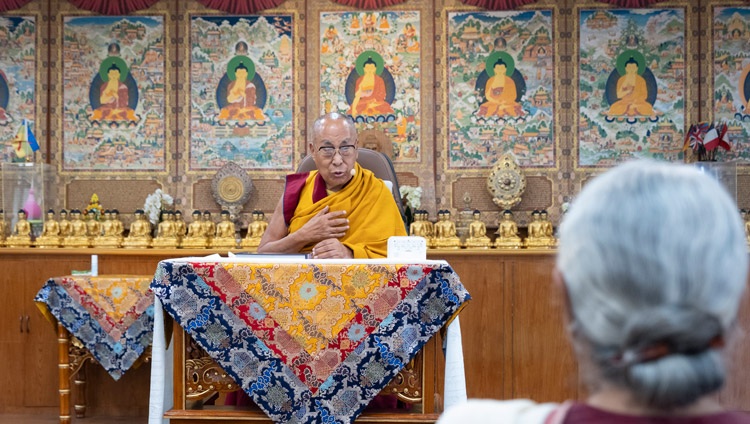
His Holiness the Dalai Lama: As soon as I wake up in the morning, I meditate and my meditation mainly comprises two principles: altruism, the awakening mind of bodhichitta and emptiness. I feel that if he were alive today I might be considered one of the students able to sit beside the great master Nagarjuna in terms of my understanding of emptiness.
September 4, 2024. Thekchen Chöling, Dharamsala, HP, India – This morning, the Board of Trustees of the Ramon Magsaysay Award Foundation (RMAF), which is based in Manila, in the Philippines, launched a seven-volume series entitled Greatness of Spirit about previous recipients of the award in the presence of His Holiness the Dalai Lama. The publication commemorates the 65th anniversary of the establishment of the award.
His Holiness was one of the earliest recipients when he was granted the award in 1959 and it was the first international award that he received. The Ramon Magsaysay Award celebrates the best of humanity, embodying the true essence of ‘Greatness of Spirit’.
Susanna B. Afan, President and Cecilia L. Lazaro, Chairperson of (RMAF) met His Holiness at the door to the audience hall and escorted him to his seat. Ms Afan wished His Holiness good morning and reminded him that she came to Dharamsala last year to present him the medal that they had been unable to physically present to him 65 years ago.
This year she was accompanied by six Ramon Magsaysay Award Laureates, the Board of Trustees and friends. She introduced some Awardees from India—Aruna Roy, TM Krishna, Harish Hande, Anshu Gupta—and Conchita Carpio Morales from the Philippines, as well as the Board of Trustees past and present.
Ms Afan requested His Holiness to speak to them.
“I was born in the North-eastern part of Tibet in a very remote part of Amdo,” he began. “Then, when I was about three or four years old, I came to Lhasa in Central Tibet, which is where I began my studies of Buddhist philosophy, logic and so forth. My teachers were brilliant. Once I had completed my formal studies in 1959 I took the examinations for the Geshé degree.
“When circumstances in Tibet changed, I had to flee into exile in India. Here I was able to meet people from many different walks of life and I found that what I had learned in Tibet was very beneficial. Along with Buddhist philosophy I also studied the views of other Indian schools such as the Samkhyas, Vaisheshikas and so forth. Here in India I was able to meet with people who upheld these various views. In addition, I was able to meet and hold discussions with modern scientists from the West.
“As part of the curriculum in the Buddhist Monastic Centres of Learning in Tibet, we studied logic, which was very helpful when it came to holding discussions with scientists and people from other religious traditions.
“In addition to non-Buddhist views we studied the various Buddhist schools of thought. As a result, I discovered I was an adherent of the Prasangika Madhyamika school of thought. Consequently, if I were to be confronted (in debate) by someone who followed the Svatantrika Madhyamika school of thought I would be able to hold my own. I discovered that the Prasangika Madhyamika use of logic is the best way to tackle such challenges.
“This logic of the Prasangika Madhyamika school is something I use every day in my meditation on emptiness. As soon as I wake up in the morning, I meditate and my meditation mainly comprises two principles: altruism, the awakening mind of bodhichitta and emptiness. I feel that if he were alive today I might be considered one of the students able to sit beside the great master Nagarjuna in terms of my understanding of emptiness.
“Besides this I consider India’s ancient principle of non-violence to be very precious. There may be differences of view between the various schools of Indian philosophy, but they all have non-violence in common. I have been familiar with this practice since I was a child. So, while I observe the practice of non-violence in my day-to-day life, I also share it with my friends. I encourage them to incorporate non-violence into their own lives.
“When I look at how the world is today, I feel it’s very important that we practise non-violence. Everyone wishes to see peace in the world, we talk about peace in the world, and if we are to achieve, it we need to raise awareness of the value of non-violence.”
https://www.dalailama.com/news/2024/meeting-with-representatives-of-the-ramon-magsaysay-award-foundation